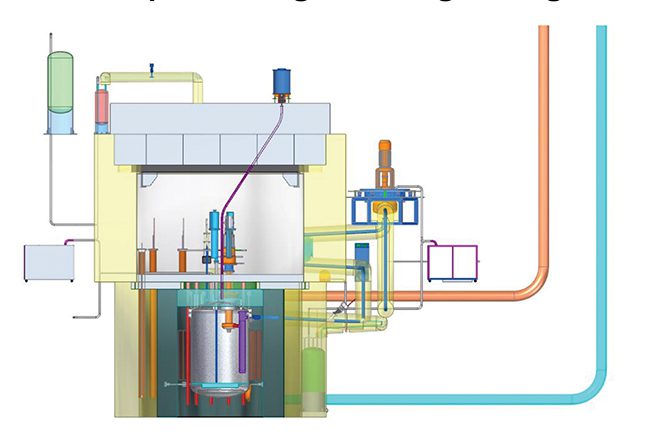China Approves Commissioning of Thorium-Powered Reactor

China's Ministry of Ecology and Environment on Aug. 2 gave Shanghai Institute of Applied Physics (SINAP) the green light to commission the experimental 2-MWth thorium-based molten salt reactor (TMSR-LF1) at the Hongshagang Industrial Cluster, Wuwei city, Gansu province. If successful, the TMSR-LF1 could pave the way for development and construction of a larger demonstration facility by 2030, as well as construction of a TMSR fuel salt batch pyroprocess demonstration facility to realize thorium-uranium cycle usage by the early 2040s.
 |
4. This graphic visualizes the thorium-based molten salt reactor (TMSR-LF1) engineering design. A 2-MWth version of the TMSR is under commissioning in China. Courtesy: SINAP |
The TMSR-LF1 is a proof-of-concept liquid fluoride thorium reactor that uses a fuel salt (LiF-BeF 2 -ZrF 4 -UF 4 [+ThF 4 ]) and a coolant salt (LiF-BeF 2). Fueled by a mix of thorium and uranium-235 (enriched at 19.75% by weight), it is designed to operate at a maximum working temperature of 650C over a 10-year lifetime. The liquid fuel design is based on Oak Ridge National Laboratory's 1960s Molten-Salt Reactor Experiment (Figure 4). SINAP documents suggest the purpose of the experiment is to test pyroprocessing, refueling, and continuous gas removal; to investigate stability and safety in the operation; and to test a thorium-uranium fuel cycle.
A Focus on ThoriumChina has since 2013 considered the project a major national scientific and technological infrastructure construction project." Documents shared by SINAP with the Generation IV International Forum suggest the experimental project is part of larger plans to develop small modular TMSRs to utilize a thorium closed fuel cycle for nuclear heat applications. Along with the liquid fuel TMSR-LF, SINAP also began developing a solid fuel MSR (TMSR-SF) that uses TRISO (TRi-structural ISOtropic particle fuel) in pebbles or prisms/blocks with a once-through fuel cycle. However, progress on that front is unclear.
While the current effort stems from a program initiated by the Chinese Academy of Sciences in 2011, SINAP has fostered ambitions to build a TMSR since 1970. A key reason is that because MSRs rely on molten salts as a means of heat transfer, they are not reliant on water, and may be suitable for arid areas like the Gobi Desert. For China, development of a thorium-based fuel cycle is also of interest owing to many advantages, especially for safety, reduced proliferation risks, and waste management.
Thorium (Th) is more abundant in nature than uranium (U), but it is fertile rather than fissile, and can only be used as a fuel in conjunction with a fissile material such as recycled plutonium," explained the World Nuclear Association (WNA). And while the use of thorium as a new primary energy source has been a tantalizing prospect for many years," extracting its latent energy value cost-effectively has been challenging, the group said.
The TMSR-LF design claims full closed Th-U fuel cycle with breeding of U-233 and much better sustainability but greater technical difficulty," the WNA added. SINAP sees molten salt fuel being superior to the TRISO fuel in effectively unlimited burn-up, less waste, and lower fabricating cost, but achieving lower temperatures [600C+] than the TRISO fuel reactors [1,200C+]," it said. Near-term goals include preparing nuclear-grade ThF4 and ThO2, and testing them in an MSR.
One of the World's First Operational Molten Salt ReactorsMedia reports suggest that the TMSR-LF1 tests will begin on a batch basis with some online refueling and removal of gaseous fission products. Reports suggest the project will discharge all fuel salt after five to eight years for reprocessing and separation of fission products and minor actinides for storage. It will also proceed to a continuous process of recycling salt, uranium and thorium, with online separation of fission products and minor actinides. The reactor will work up from about 20% thorium fission to about 80%," World Nuclear News reported.
If successfully commissioned, the TMSR-LF1 project will become one of the world's first operational MSR reactors in decades. The project's rapid progress is notable. After the Ministry of Ecology and Environment granted the institute's request to begin preliminary work on TMSRs as research reactors in 2015, it selected the Hongshagang site in December 2018. Ministry documents suggest the experimental project will comprise the reactor facilities, a radioactive waste treatment center, a security control center, and a comprehensive experiment hall and chemical warehouse."
The ministry approved an environmental impact report for the project in December 2019, and it issued a construction license for the TMSR-LF1 shortly afterward, in January 2020. China's National Nuclear Safety Administration and the ministry have reportedly monitored construction quality. While the ministry in August granted its approval to begin commissioning, it urged SINAP to strictly implement" a commissioning outline to ensure the effectiveness of the implementation of the outline and ensure the safety and quality of debugging." On Aug. 11, the ministry also approved a quality assurance program for the project.
-Sonal Patelis a POWER senior associate editor (@sonalcpatel,@POWERmagazine).
The post China Approves Commissioning of Thorium-Powered Reactor appeared first on POWER Magazine.